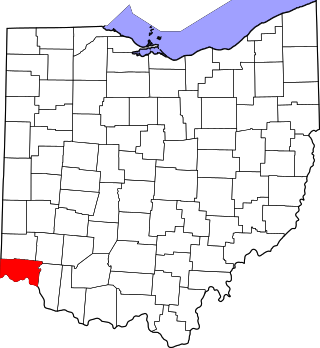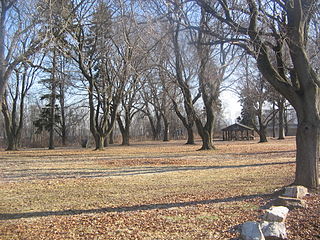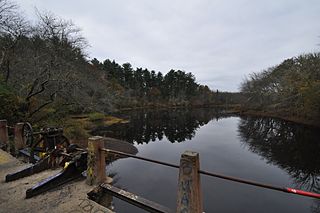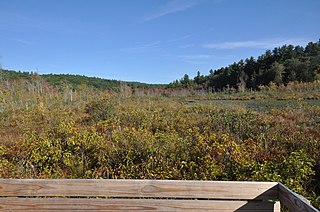Related Research Articles

The Koster Site is a prehistoric archaeological site located south of Eldred, Illinois. The site covers more than 3 acres and extends 30 feet down into the alluvial deposits of the Illinois River valley. Over the course of its excavation between 1969 and 1978, Koster produced deeply buried evidence of ancient human occupation from the early Archaic period to the Mississippian period. The soil strata contains a total of 25 distinct occupations each separated by additional layers of soil, making the site exceptionally well-preserved.

This is a list of the National Register of Historic Places listings in Hamilton County, Ohio.

The Lindenmeier site is a stratified multi-component archaeological site most famous for its Folsom component. The former Lindenmeier Ranch is in the Soapstone Prairie Natural Area, in northeastern Larimer County, Colorado, United States. The site contains the most extensive Folsom culture campsite yet found with calibrated radiocarbon dates of c. 12,300 B.P.. Artifacts were also found from subsequent Archaic and Late pre-historic periods.

The Lamoka site, or simply Lamoka, is an archaeological site near Tyrone, in Schuyler County, New York that was named a National Historic Landmark in 1961. According to the National Park Service, "This site provided the first clear evidence of an Archaic hunting and gathering culture in the Northeastern United States ".

The Modoc Rock Shelter is a rock shelter or overhang located beneath the sandstone bluffs that form the eastern border of the Mississippi River floodplain at which Native American peoples lived for thousands of years. This site is significant for its archaeological evidence of thousands of years of human habitation during the Archaic period in the Eastern United States. It is located on the northeastern side of County Road 7 southeast of Prairie du Rocher in Randolph County, Illinois, United States. It was declared a National Historic Landmark in 1961.

Silver Mound is a sandstone hill in Wisconsin where American Indians quarried quartzite for stone tools. Tools made from Silver Mound's quartzite have been found as far away as Kentucky. The oldest have been dated to around 11,000 years ago, so they provide clues about the first people in Wisconsin. Silver Mound Archeological District was declared a National Historic Landmark in 2006.

The Abbott Farm Historic District is a National Historic Landmark archaeological site in New Jersey. It is the largest known Middle Woodland village of its type on the East Coast of the United States. Significant evidence suggests that the Delaware River floodplain was occupied by Paleoindian people for a long period. It was inhabited between 500 BC and 500 AD. It has been a source of controversy and debate around early development.

Accokeek Creek Site, also known as Moyaone, is an archaeological site in Prince George's County, Maryland, located along the Potomac River across from Mount Vernon in today's Piscataway Park, which was inhabited intermittently since 2000 BC. Accokeek Creek Site was declared a National Historic Landmark in 1964.

Cedar Swamp Archeological District is a prehistoric and historic archaeologically sensitive area in eastern Westborough, Massachusetts, and extending into the northwest corner of Hopkinton. Cedar Swamp is an area of more than 2,600 acres (1,100 ha) of wetlands that include the headwaters area of the Sudbury River. Archeological surveys of the environmentally sensitive and critical area have identified many Native American sites of interest. It is believed that Native Americans prized wood from the cedar trees that grew in the area. The archeological district, which encompasses much of the Cedar Swamp area, was added to the National Register of Historic Places in 1988.

The Green Hill Site is a prehistoric archaeological site in Canton, Massachusetts. It is located near the Neponset River, extending upland for a distance of about 500 feet (150 m) up to the crest of Green Hill, an elevation of about 110 feet (34 m). This area has been repeatedly excavated since the 1960s. The site encompasses a Middle to Late Archaic period encampment, where Neville style projectile points, gouges for woodworking, and a stone-working worksite have been found.

The Memorial Park Site is an archaeological site located near the confluence of Bald Eagle Creek and the West Branch Susquehanna River in Lock Haven in the U.S. state of Pennsylvania. Research projects conducted at the site since 1979 have found prehistoric cultural deposits that collectively span 8,000 years.

The Sommerheim Park Archaeological District includes a group of six archaeological sites west of Erie, Pennsylvania in the United States. The sites are in Sommerheim Park, one of the few undeveloped areas of the Lake Erie shoreline, in Millcreek Township. This district has been listed on the National Register of Historic Places. This is one of the leading archaeological sites in the Erie area and along the southern shoreline of Lake Erie, due to the amount of artifacts and the lack of disturbance on the site.

The Cary Village Site is an archaeological site in the west-central portion of the U.S. state of Ohio. Located southeast of the village of Plain City in Madison County, the site occupies a group of grassy terraces located amid two farm fields. In this grassy area, archaeologists have discovered a wide range of artifacts, including stone tools, materials made of flint, and various types of pottery.

The LoDaisKa site is a prominent archaeological site in the U.S. state of Colorado, located within a rockshelter near Morrison. The rockshelter was first inhabited by people of the Archaic through the Middle Ceramic period, generally spanning 3000 BC to 1000 AD.

Roxborough State Park Archaeological District is located in Douglas County, Colorado. Roxborough State Park, 25 miles (40 km) south of Denver, Colorado, is a Colorado State Park day park. Archaeological artifacts reflect that there were prehistoric hunter-gatherers who lived or camped, made tools from stone quarries, and farmed in the Roxborough State Park area.
The Trinchera Cave Archeological District (5LA9555) is an archaeological site in Las Animas County, Colorado with artifacts primarily dating from 1000 BC to AD 1749, although there were some Archaic period artifacts found. The site was added to the National Register of Historic Places in 2001 and is located on State Trust Lands.
The Roberts Farm Site (36LA1) is an historic, American archaeological site that is located above the Conestoga River in Manor Township in Lancaster County, Pennsylvania.
Daugherty's Cave and Breeding Site is a Native American archaeological site in Russell County, Virginia, near Lebanon. The site includes materials dating from the Early Archaic Period to the time of European contact. Digs at the site have recovered large numbers of animal bones dating from the Middle Archaic Period.

Conant's Hill Site is an archaeological site in Wareham, Massachusetts. The area, located around Horseshoe Pond just north of Interstate 195, is a multicomponent site that includes both industrial remains dating to the 18th century, and Native American artifacts. During excavations in 1947, remains of four Native Americans were exhumed, along with a lead ring, evidence that they were post-contact burials. The site also includes a midden, with prehistoric artifacts dating as far back as the Late Archaic.

The Beaver Meadow Complex Prehistoric Archeological District is a grouping of archaeological sites in Peoples State Forest, Barkhamsted, Connecticut. It consists of eight separate sites in the Beaver Meadow area of the forest, from which radiocarbon dates from the Archaic to the Middle and Late Woodland Period have been obtained. The sites were identified during surveys conducted 1983-85 by teams from Central Connecticut State University. This work was done as part of a larger scale survey of the Connecticut sections of the upper Farmington River valley.
References
- 1 2 "National Register Information System". National Register of Historic Places . National Park Service. April 15, 2008.
- ↑ "Archaeological Overview and Assessment, Bunker Hill Monument" (PDF). National Park Service. Retrieved March 19, 2012.
- ↑ "Middle Archaic Settlement in the Cochato-Monatiquot River Drainage: The Gill Farm Sites, Randolph, Massachusetts" (PDF). Bridgewater State University. Retrieved November 13, 2017.
- ↑ "2014 Annual Report" (PDF). Robert S. Peabody Museum. Retrieved September 10, 2015.
